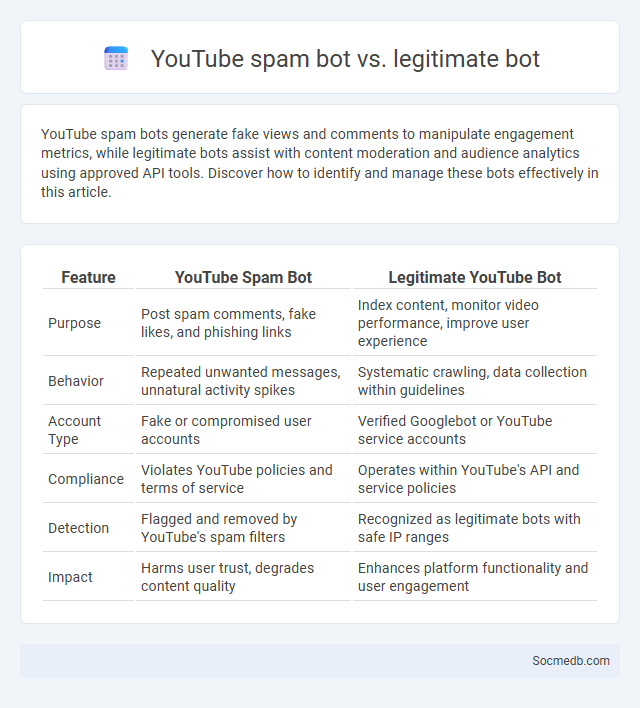
Photo illustration: YouTube spam bot vs legitimate bot
YouTube spam bots generate fake views and comments to manipulate engagement metrics, while legitimate bots assist with content moderation and audience analytics using approved API tools. Discover how to identify and manage these bots effectively in this article.
Table of Comparison
| Feature | YouTube Spam Bot | Legitimate YouTube Bot |
|---|---|---|
| Purpose | Post spam comments, fake likes, and phishing links | Index content, monitor video performance, improve user experience |
| Behavior | Repeated unwanted messages, unnatural activity spikes | Systematic crawling, data collection within guidelines |
| Account Type | Fake or compromised user accounts | Verified Googlebot or YouTube service accounts |
| Compliance | Violates YouTube policies and terms of service | Operates within YouTube's API and service policies |
| Detection | Flagged and removed by YouTube's spam filters | Recognized as legitimate bots with safe IP ranges |
| Impact | Harms user trust, degrades content quality | Enhances platform functionality and user engagement |
Introduction to YouTube Bots
YouTube bots are automated software designed to mimic human interactions such as liking, subscribing, and commenting on videos, significantly impacting channel growth and engagement metrics. These bots manipulate YouTube's algorithm by inflating view counts and engagement rates, often leading to skewed analytics and unfair competition. Understanding the functioning and implications of YouTube bots is crucial for content creators aiming to maintain authentic audience interactions and comply with platform policies.
What Are YouTube Spam Bots?
YouTube spam bots are automated software programs designed to post irrelevant, misleading, or promotional comments on videos to manipulate engagement metrics or spread spam content. These bots can generate fake likes, views, and subscriptions, artificially inflating the popularity of channels or videos. Their activity disrupts genuine user interaction and violates YouTube's community guidelines, prompting constant efforts to detect and remove spam bot accounts.
Characteristics of Spam Bots on YouTube
Spam bots on YouTube often exhibit repetitive posting patterns, flooding comments with irrelevant or promotional content that disrupts genuine engagement. These bots typically generate accounts with generic usernames and use automated scripts to like videos or subscribe to channels, artificially inflating popularity metrics. Recognizing these behaviors helps you maintain your community's integrity by filtering out spam and fostering authentic interactions.
Legitimate Bots on YouTube: Definition and Purpose
Legitimate bots on YouTube are automated programs designed to perform specific tasks such as content moderation, comment filtering, and data analysis to enhance user experience and platform security. These bots help manage vast amounts of data by identifying spam, enforcing community guidelines, and providing real-time analytics for creators and advertisers. By automating repetitive processes, legitimate bots improve efficiency while ensuring compliance with YouTube's policies.
Key Differences: Spam Bot vs Legitimate Bot on YouTube
Spam bots on YouTube aggressively post irrelevant comments, artificially inflate views, and distribute malicious links, negatively impacting user experience and platform integrity. Legitimate bots, such as YouTube's official content moderation bots, efficiently filter inappropriate content, manage video recommendations, and enhance user engagement without violating platform policies. Understanding behavioral patterns like comment authenticity, interaction frequency, and link validity helps differentiate between harmful spam bots and beneficial legitimate automation tools on YouTube.
How Spam Bots Disrupt YouTube Communities
Spam bots flood YouTube communities with irrelevant comments and fake accounts, undermining genuine user interactions and community trust. These automated accounts distort engagement metrics, making it harder for creators to accurately assess audience interest and for viewers to find authentic content. Protecting your YouTube community requires vigilant monitoring and the use of advanced spam detection tools to maintain a healthy, interactive environment.
Detection Methods: Identifying Spam Bots
Detection methods for identifying spam bots on social media rely heavily on machine learning algorithms that analyze behavioral patterns such as posting frequency, content similarity, and interaction anomalies. Advanced techniques incorporate natural language processing (NLP) to detect repetitive or nonsensical messages often generated by bots. By understanding these detection methods, you can better protect your social media accounts from spam bot intrusion.
Advantages of Using Legitimate Bots on YouTube
Legitimate bots on YouTube enhance content discovery by automating the organization of videos and improving search engine rankings through optimized metadata management. These bots facilitate real-time analytics tracking, enabling creators to adjust strategies based on accurate viewer engagement data. Utilizing authorized automation tools also helps maintain compliance with YouTube's policies, reducing the risk of account suspension and fostering sustainable channel growth.
YouTube’s Policies and Actions Against Spam Bots
YouTube's policies strictly prohibit spam bots to maintain authentic engagement and user safety across the platform. Your content and interactions must comply with guidelines that ban deceptive practices, such as artificially inflating views, likes, or comments through automated programs. The platform employs advanced detection systems and enforces penalties, including account suspension, to combat spam bots and ensure genuine community participation.
Best Practices: Staying Safe from Spam Bots on YouTube
To stay safe from spam bots on YouTube, regularly update privacy settings and enable comment moderation tools to filter out suspicious content. Use two-factor authentication to secure your account from unauthorized access and report any suspicious channels or comments immediately. Engaging actively with verified channels and avoiding unknown links can further reduce the risk of encountering spam bots.
 socmedb.com
socmedb.com